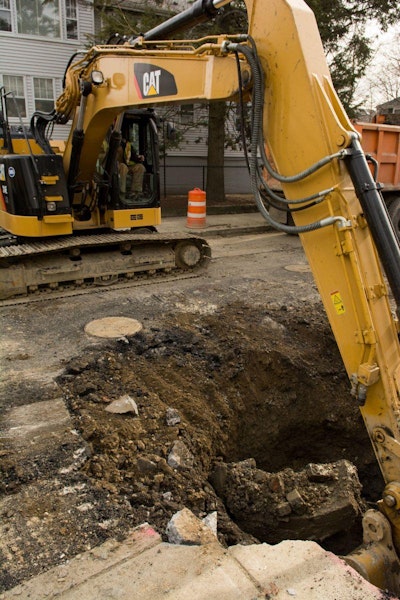
Interested in Stormwater?
Get Stormwater articles, news and videos right in your inbox! Sign up now.
Stormwater + Get AlertsIn the battle for tax dollars, aging infrastructure might have an unlikely ally in potholes and traffic congestion.
Carl Weber, retired public works director for the City of Janesville, Wisconsin, and president of the American Public Works Association (APWA), Wisconsin Chapter, at least offers the scenario as a way to upgrade water and sewer systems in today’s no-spend culture.
“Unfortunately, most infrastructure is underground, so the general public doesn’t see it,” he says. “They don’t have the same level of appreciation for the deterioration that has occurred there as they do with streets where you can see the potholes or you can see the traffic congestion.”
Like many who work in the public sector, Weber has tried to tie water and sewer updates to street projects. But even those dollars are beginning to run dry.
“We’re not improving the streets as fast and therefore we’re not getting underground and improving the utilities as quickly,” he says. “Overall, the amount of funding hasn’t kept up with the needs.”
That’s hardly news to water, sewer and stormwater managers who face increased competition for an ever-shrinking piece of the public pie. Weber believes one way to reverse the trend is for municipalities to become more vocal in their needs.
“I think we just have to tell the story,” he says. “We have to let the people know what the needs are out there and hope that they can understand that, believe it, trust it and invest in it.”
Stormwater utilities
David Mason, principal engineer with CDM Smith, a consulting firm in Nashville, Tennessee, and a member of the APWA Water Resource Management Committee, says any discussion on funding needs to include stormwater utilities.
“It still remains a hot topic with the cities that I deal with that do not have them,” he says. “Also, there are still states where stormwater utilities are not explicitly authorized by state law. This makes it risky for cities to move forward with implementation for fear of being sued.”
According to the 2014 Western Kentucky University Stormwater Utility Survey, there are about 1,500 stormwater utilities in the U.S. The smallest community with a stormwater utility is Indian Creek Village, Florida, with a population of 88, while the largest is Los Angeles. Stormwater utility fees range from zero to $35 a month. Nationwide the average monthly single family residential stormwater fee is $3.98.
“I think in the long run you’ll see stormwater programs funded more like water and sewer programs,” Mason says. “Water and sewer utilities were funded by tax revenues just like stormwater is now before the Clean Water Act came around. They went through that same evolution. I think we’re seeing stormwater programs going through that evolution now.”
Todd Wagner, principal stormwater engineer with the City of Springfield, Missouri, says compared to monthly drinking water fees of $20 to $30 and wastewater rates that are rapidly heading past $50 a month, it’s safe to suggest that stormwater is grossly underfunded.
“Many communities fund their programs with one or a combination of utility, sales tax, property tax, highway and road funds, general funds or through other regional or state programs, but most do not have adequate, long-term funding,” he says.
“In Springfield, we have annual operation needs of $3 to $5 million, a system replacement cost of over $500 million and high-priority capital needs of over $200 million, yet we just lost our 5-year sunset sales tax and now our income is at a crisis level of less than $2 million. With drinking water, wastewater, transportation, police and fire grabbing all the public attention, there’s not much interest in funding stormwater.”
Wagner says until more funding becomes available, a short-term solution might be better utilization of existing resources.
The need to go green
“I think green infrastructure (GI) approaches are great for a double or even triple bang for the buck,” he says. “They can meet flood control, infrastructure replacement and water quality objectives simultaneously, along with other social and environmental benefits. Maybe there’s a way to reconstruct our drainage system that’s more friendly to the environment. Maybe it can be built in a way that while you’re rebuilding your infrastructure you can address your water quality and flooding at the same time.”
Springfield also has tapped into state and federal clean water grants to fund stormwater awareness programs, including a contest to redesign manhole covers and an annual competition that invites artists to paint stormwater murals on downtown drains.
“As I look forward, I can see the storm systems of the future being more open, more green and more natural, providing multiple benefits like trails and parks,” Wagner says.
One such project in Springfield replaced an underground box culvert with a green channel that’s designed to behave like a natural stream.
“It has a natural gravel bottom with plants and trees growing along the sides,” he says. “It has shade. It has contact with soil and root structures. You get plant uptake that helps cleanse the water. You have pools and ripples that provide habitat and oxygen into the water. And then you can have a walkway trail and let the vegetation grow up that attracts birds and butterflies. It’s a nice amenity for a city to have.”







